
Student Projects
VG100

Automatic Ping-pong Ball Collector
Instructors: Dr. Mian Li, Dr. Irene Wei
Team Members: Wenjie Geng, Xinyue Yang, Yunqi Zhang, Zhekai Xu, Zi Ye
Project Video
Team Members

Team Members:
Wenjie Geng, Xinyue Yang, Yunqi Zhang, Zhekai Xu, Zi Ye
Instructors:
Dr. Mian Li, Dr. Irene Wei
Project Description
Problem
Ping-pong is a worldwide popular sport. However, for professional players during training or amateur players enjoying the game, pausing to take the time and effort to collect fallen balls is always a bother. Existing solutions either involve manual control or can’t serve as satisfactory automatic alternatives.
Concept Generation
Our project aims at designing and building a ping pong ball collector car that accurately & efficiently performs the task of automatically picking balls in real life circumstances. The robotic car features image recognition, efficient ball-picking, agile movement and obstacle avoidance.
Design Description
The ping-pong ball collector car (Fig 1.) design consists of 5 major parts. The main frame is constructed with PVC and wooden board. The collecting unit involving intelligent ball recognition system (Fig 2.) and a flipping baffle for ball picking is placed in the front. The space for ball storage is at the center. The lifted obstacle avoiding unit consists of sensors that detect walls or other obstructions in its way. The control unit–– Arduino Uno serves to connect units together and directs movements of the car by data analysis.
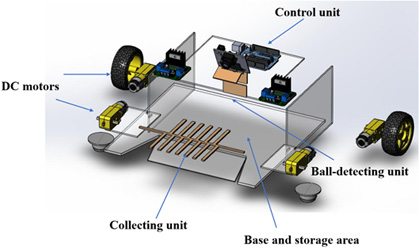
Fig. 1 Concept diagram of robotic car
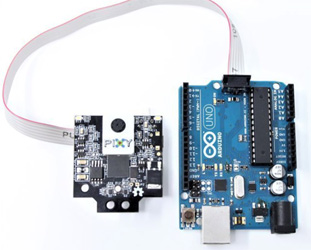
Fig. 2 Ball recognition–– Pixy2 unit
Modeling and Analysis
The robotic car system utilizes Pixy2, Arduino Mega, a roller and container, 3 motors (for wheels and the roller), ultrasonic sensors and infrared sensors. The robot learns the size and color of the ping-pong ball for recognition through the Pixy2 module in advance. When in operation, the system recognizes the ping-pong ball (Fig 3. & Fig 4.) and alters its direction to aim at the ball, and then moves forward. Once in position, the car will adjust itself and stop, the roller will roll automatically to let the ball be collected in the container, and then users can open the lid to get the balls. During its path of ball picking, a system which consists of ultrasonic sensors and infrared sensors helps it avoid possible obstacles.
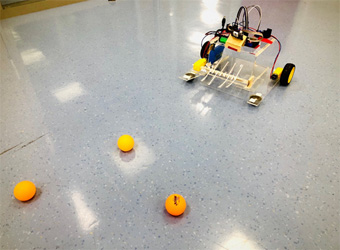
Fig. 3 Robotic car in operation
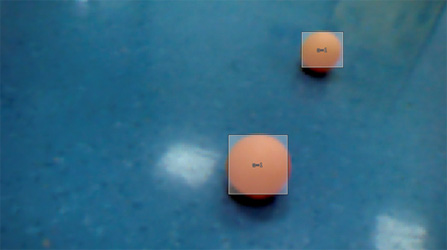
Fig. 4 Camera view in operation
Validation
We did a sample test to find out the percentage of balls that can be successfully collected, in order to validate our product.
With the 4 trials, we found that as the total number of balls increases, the success rate decreases a bit. But the overall success rate is quite satisfactory. In the subsequent adjustment stage, we still need to further optimize the route of ball picking to improve the success rate.
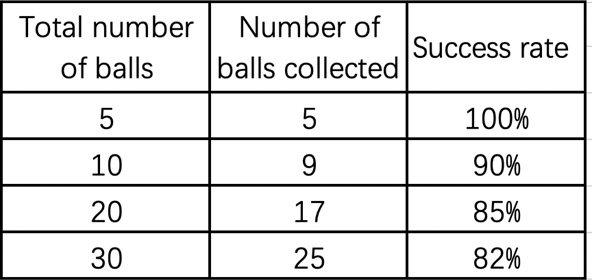
Table 1. Success rate of ball picking
Conclusion
Our project solves the problem by producing this automatic ping-pong ball picking car. It frees ping-pong players from the trouble of spending extra time and effort to seek and collect balls. It also maximizes convenience of user through automation, enlarged storage space and intelligent obstacle avoidance. One possible improvement is to add a ball counting unit to ensure no balls are missed out during collection. The results of our project may be further applied to other ball games such as tennis and golf, thus bringing more efficiency to sport lovers.
Acknowledgement
Dr. Mian Li and Dr. Irene Wei from the UM-SJTU Joint Institute;
Teaching Assistants Hanyang Feng, Fubo Qi, Sheng Qiao, Xiaoxuan Wang for VG100 at UM-SJTU Joint Institute.
More project information, please contact: xuzhekai@sjtu.edu.cn
Teaching Assistants Hanyang Feng, Fubo Qi, Sheng Qiao, Xiaoxuan Wang for VG100 at UM-SJTU Joint Institute.
More project information, please contact: xuzhekai@sjtu.edu.cn
UM-SJTU JOINT INSTITUTE